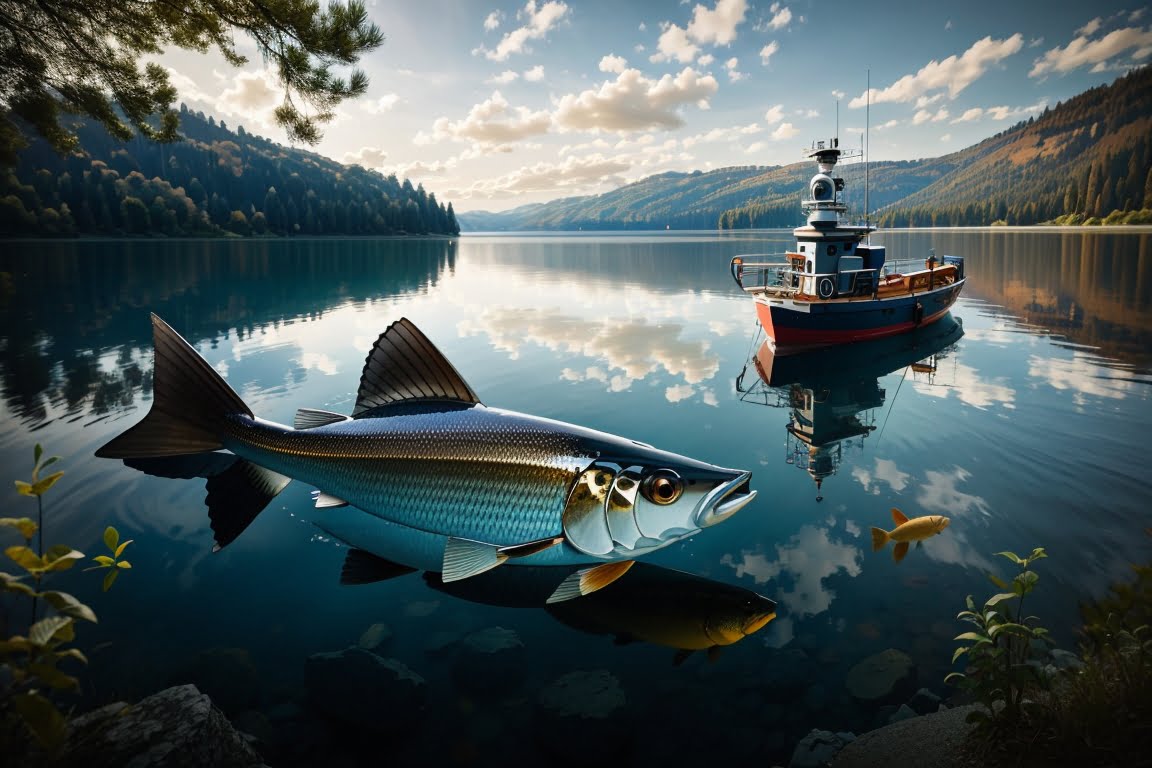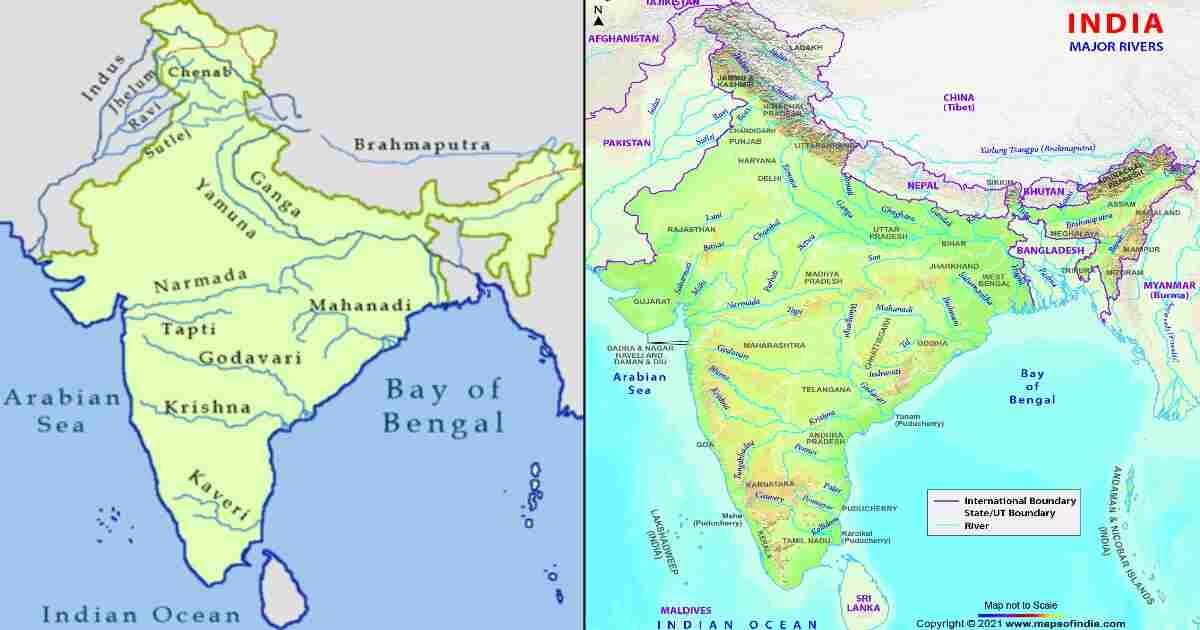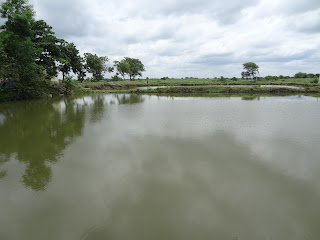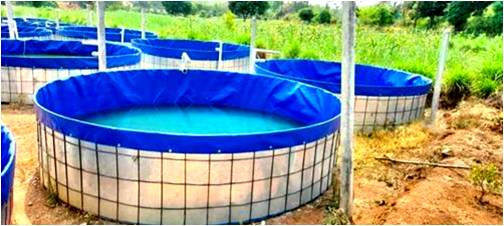Reservoir Fisheries: Reservoirs which are man-made lakes created by damming rivers. Reservoirs provide a variety of habitats for fish, including shallow littoral zones, deep pelagic zones, and riverine zones. This diversity of habitats supports a wide variety of fish species, including both native and introduced species.
In India, reservoir fisheries are an important source of fish for both subsistence and commercial purposes. The country has a large number of reservoirs, and the average fish yield from reservoirs is estimated to be 29 kg/ha. The highest fish yields are found in small reservoirs, followed by medium and large reservoirs.
The most important fish species in Indian reservoir fisheries are carps, catfishes, and tilapias. Carps are the most abundant fish species in Indian reservoirs, and they are an important source of food for both humans and livestock. Catfishes are also an important fish species in Indian reservoirs, and they are a popular game fish. Tilapias are an introduced species, but they have become well-established in Indian reservoirs and are now an important commercial fish species. ‘Reservoir Fisheries’
The management of reservoir fisheries is important to ensure the sustainability of these fisheries. Management measures include water quality management, predator control, and fishing regulations.
Reservoir Fisheries
India has a large spread of fresh water resources in the form of rivers, reservoirs, lakes, ponds. Indian reservoirs, being in the tropics, have high primary productivity and have the capacity to produce more fish than their present low Indian average of 29.7 kg/ha/yr in reservoirs. Reservoir fisheries are essentially a stocking cum capture system. There are 975 reservoirs in the country with a total area of more than 3.15 million hectares.
River water is usually running or flowing water. Construction of dam results in the creation of a reservoir or dam- lake, in which the lotic water of the upper reaches becomes lentic as water approaches the dam. Rise in reservoir depends upon river flow and rain water. A new reservoir passes through three trophic phases- initial fertility, trophic depression and final fertility. Filling of a reservoir inundates vast area bearing a cover of vegetation. It starts decaying and putrefaction results initial fertilization of the water leading to an intense development of fish food in the form of benthic micro and macro flora and fauna. The initial increase of biota is often spectacular. After the initial high fertility, trophic depression phase sets in. This is cause by gradual diminishing of the rate of nutrient release. This is due to increase in the volume of the impounded water and available nutrients used by the vegetation. After this phase is passed the final fertility level is reached in the reservoir, which is a much lower level than that of initial fertility. ‘Reservoir Fisheries’
Reservoir Ecology:
Reservoir ecology is changed from the reverine ecology because, in reservoirs, the lotic water of the upper reaches becomes lentic as water approaches the dam. This facilitates entirely different types of fishery called reservoir fishery, to suit the ecology of the reservoir. A reservoir has its own peculiarities in which it differs from natural lakes. The revirine ecology of the water of the upper reaches becomes increasingly changed into lacustrine ecology in the reservoir. The benthic riverine fauna disappears and it is replaced by typical lacustrine benthic fauna. With the change in from the lotic to lentic conditions of the water current, riverine plankton are replaced by lacustrine plankton. The turbidity level also reduced as reservoir act as settling basins. Fish fauna is greatly affected. The running water fish species become fewer or completely eliminated. Slow water fish species are predominant. Floating plants may come up, particularly in tropics where they create deoxygenating conditions or cause other serious ecological problems.
The dam in some way interferes with the ecology of the upper reaches of the river. Migratory fishes are completely wiped out from the upper reaches. This often leads to disturbances in the ecosystem especially with advantage to the prey. The reservoir it self may affect the ecology of the lower reaches of the river. Periodical discharge of sediments from the reservoirs may cause mud and silting in the lower reaches with serious consequences on the fauna. Reservoir acts as fertility traps, reducing the amount of dissolved plant nutrients which would other wise be freely arriving at the lower reaches. ‘Reservoir Fisheries’
Classification of reservoirs:
The reservoirs are classified by many authors in different ways mainly based on the area of reservoirs. Mohanty (1984) reported three types of reservoirs.
Minor reservoirs – with water spread area up to 40 ha.
Medium reservoirs – With water spread area upto 400 ha.
Major reservoirs – with the water spread area above 400 ha.
Pathak (1990) classified the reservoirs into three categories.
Large reservoirs – covering an area of 5000 and more hectares.
Medium reservoirs – having impounded water spread area of 1000 –5000 hectares.
Small reservoirs – having water spread area less than 1000 hectares.
Agarwal (1990) classified the reservoirs, keeping in view the availabilities and other factors of management into four categories.
Large reservoirs – the water spread area between 1000 – 5000 ha.
Medium reservoirs – the water spread area between 100 – 1000 ha.
Minor reservoirs – the water spread area between 10 – 100 ha.
Small reservoirs – the water spread area below 10 ha.
Jhingran and Sugunan (1990) classified the reservoirs into these groups.
Large reservoirs – the water spread area more than 1000 ha.
Medium reservoir – the water spread area is in between 500 – 1000 ha.
Small reservoirs – the water spread area is less than 500 ha.
Management of Reservoir fisheries
The fish production from the reservoirs is low, emphasizing the need for attention to shape and develop the reservoir fisheries from the survey and planning stage to achieve high rate of production and better returns for the fishermen, who represent the weaker section of the society. Majority of these water bodies are not scientifically managed. Only a handful has so far been harnessed on scientific lines, while the others are either half-heartedly managed or even not managed at all. ‘Reservoir Fisheries’
There are marked variations in the fishery management practices which are followed in various reservoirs within the country. Even though the reservoirs are owned by the Government or Corporate agencies in most of the states, their fishing rights and exploitation systems vary considerably. The fishing systems can be divided into the following broad categories:
a) Privately owned and managed reservoirs,
b) Public water bodies,
c) Community water bodies and
d) Water bodies managed by the Government.
After a scrutiny of the various management practices followed in the country, it is difficult to miss a common underlying spirit of the common property norm. Majority of Indian reservoirs are public properties where a fixed number of licensed fishermen make their living. The exceptions are the small reservoirs in some states like Karnataka and Uttar Pradesh, which are auctioned to private individuals on annual basis.
The following steps are to be taken for the development of reservoir fisheries. Some of them are
- Pre- impoundment survey of the reservoir
- Removal of obstacles like tree stumps.
- Fish farm construction at the dam site for stocking of fish seed adequately.
- Organization of fishermen co-operative society for harvesting the fish in the reservoir and to take up fish marketing.
- Implementation of conservation methods to prevent over exploitation and to prevent catching of small fish.
Pre – impoundment survey:
Before formation of reservoir studies and investigations were taken up in the rivers connected to know the possible effects of fisheries. In case of the dams constructed, the dam constructing authorities should facilitate necessary fish ways for fish migration. The authorities also assess the fishermen living in the villages and their craft & tackles thatare going under the submergence of the reservoir. The above measures are to be taken up before formation of the reservoir to assess and to plan for future development of fishery in the reservoir. ‘Reservoir Fisheries’
Removal of obstacles under submergence:
After formation of the reservoir, it should facilitate easy fishing with modern fishing methods. To facilitate the above, the trees, buildings, boulders are to be removed either by mechanical means or manually.
Construction of fish seed farms at dam site:
Some of the reservoirs have got river connection as such, they will have natural stocking of fish seed (auto stoking). The reservoirs, which will have a deep column of water, will greatly affect the breeding grounds of the fish. Further more the height of the dam is another major obstruction for the movement of the fish from the lower stretch of the river to upper stretches. All these factors leads to low productivity, which drags the attention of many authorities towards the fish seed stocking every year in the reservoirs. Keeping in view of this, planning has to be done for establishment of a fish seed farm near the dam site. The Department of fisheries, Govt. of Andhra Pradesh made an attempt to promoting the fishery wealth in the reservoirs, by constructing the fish seed farms at Thandva, Wyra, Kinnerasani, Palair, Nagarjuna Sagar, Nizam Sagar, Dindi, Jurala, Kadam, Araniyar, Bahuda, Somasila, Sriram Sagar and Lower Manair dam. ‘Reservoir Fisheries’
Stocking of the fish seed in reservoirs:
An adequate sized fish seed should be stocked in the reservoirs. The tender stages of fish seed like fry (22-25 mm), fingerlings (40-50 mm) are susceptible and are to be eaten by the carnivorous fishes. Hence the reservoirs to be stocked with an advanced fingerlings (100-120 mm). Stocking of reservoirs with fingerlings of economically important fast growing species to colonies all the diverse niches of the biotype is one of the necessary prerequisites in reservoir fishery management. This has proved to be a useful tool for developing fisheries potential of such small aquatic systems. Agarwal (1990) recommended the following stocking rates in reservoirs. ‘Reservoir Fisheries’
- Large reservoirs (1000 -5000 ha) – 500 fry/ha/yr.
- Medium reservoirs (100-1000 ha) – 1000 fry/ha/yr.
- Minor reservoirs (10-100 ha)- 2000 fry/ha/yr.
- Small reservoirs (below 10 ha) – 10000 fry/ha/yr.
Srivastava (1985) recommended the following stocking rates of fingerlings for reservoirs in India.
- Large reservoirs (5000 -10000 ha) – 200 fry/ha/yr.
- Medium reservoirs (1000-5000 ha) – 400 fry/ha/yr.
- Minor reservoirs (up to 1000 ha) – 1000 fry/ha/yr.
Implementation of conservancy methods to prevent over exploitation:
It has been observed that fishes of mature major carp fishes migrate to the rivers for breeding, where the fishermen lead to catch them and destroy their breeding grounds. The breeding grounds of these fishes are to be identified and necessary protective measures are to be taken up. It is also observed that during rainy season, the big fishes migrate towards the dam site along the canals and congregate at the gates, which has been catch by the fishermen folk. This is to be reduced. The conservancy methods like mesh size regulation, observing the closed season for fishing, strict observation of prohibiting the unethical means of fishing are to be implemented strictly by the Government. ‘Reservoir Fisheries’
Species enhancement:
Decline of indigenous fish stocks due to habitat loss, especially that caused by dam construction, is a universal phenomenon. Planting of economically important, fast growing fish from outside with a view to colonising all the diverse niches of the biotope for harvesting maximum sustainable crop from them is species enhancement. It can be just stocking of a new species of introductions. Here introduction means one time or repeated stocking of a species with the objective of establishing its naturalized populations. This widespread management practice has more relevance to larger water bodies where stocking and recapture on a sustainable basis is not feasible. ‘Reservoir Fisheries’
Introduction of exotics:
In India, the fish transferred on trans-basin basis within the geographic boundaries of the country is not considered as exotic and there are no restrictions on them. Thus, catla is not regarded as exotic to peninsular rivers. This is despite the fact that the peninsular rivers have habitats distinctly different from those of Ganga and Bhrahmaputra. Catla, rohu. and mrigal have been stocked in the peninsular reservoirs for many decades now. with varying results. In some of the south Indian reservoirs, they have established breeding populations. The hallmark of the Indian policy on introductions is the heavy dependence on Indian major carps. There is evidence that the Gagetic major carps have affected the species diversity of peninsular cyprinids. ‘Reservoir Fisheries’
The Indian policy on stocking reservoirs, though not very explicit, disallows the introduction of exotic species into the reservoirs. However, common carp is very popular in reservoirs of the northeast where it enjoys a favourable microclimate and a good market. Silver carp and grass carp are not normally encouraged to be stocked in Indian reservoirs, though they are stocked regularly in a few small reservoirs. The three exotic species brought in clandestinely by the fish farmers, bighead carp..Aorichthys nobilis, Oreochromis niloticus and African catfish Clarius gariepinus have not gained entry into the reservoir ecosystems. They still remain restricted to the culture systems. ‘Reservoir Fisheries’
Environment enhancement:
The improvement of the nutrient status of water by the selective input of fertilisers is a very common management option adopted in intensive aquaculture. If similar environmental enhancement is adopted in small reservoirs, stocks can be maintained at levels higher than the natural carrying capacity of the environment. However, scientific knowledge to guide the safe application of this type of enhancement and the methods to reverse the environmental degradation, if any. Is still inadequate. On account of all these, this is not a very common management tool. China is known to have used this instrument in a big way to augment production from small reservoirs. Cuba, taking a clue from China has tried manuring of small reservoirs using both organic and inorganic fertilisers. This is also practised selectively in the community water bodies of Thailand. ‘Reservoir Fisheries’
Fertilisation of reservoirs as a means to increase water productivity through abetting plankton growth has not received much attention in India. Multiple use of the water body and the resultant conflict of interests among the various water users are the main factors that prevent the use of this management option. Surprisingly, fertilization has not been resorted to even in reservoirs which are not used for drinking water and other purposes. Documentation on fertilisation of reservoirs in India is scarce. Sreenivasan and Pillai (1979) attempted to improve the plankton productivity of Vidur reservoir by the application of super phosphate with highly encouraging results. As soon as the canal sluice was closed, 500 kg super phosphate with P,O5 content of 16 to 20 % was applied in the reservoir when the water spread was 50 ha with a mean depth of 1.67 m. As an immediate result of fertilisation, phosphate content of water increased from nil to 1.8 ppm and that of soil from 0.242 to 0.328 %. Similar improvements in organic carbon nitrogen have been reported from soil and water phases on account of fertilisation. Experiments were also conducted with urea in the same reservoir.
Fertilisation can play a key role in many small reservoirs of India which require correction of oligotrophic tendencies. A number of reservoirs in Madhya Pradesh. the Northeast and the Western Ghats receiving drainage from poor catchments show low productivity, necessitating artificial fertilisation. Chinese experience in fertilising the small reservoirs for increasing productivity has been reassuring (Yang etal., 1990). ‘Reservoir Fisheries’
Fertilisers are less effective in soft water with total alkalinity less than 20 ppm. Soft waters have inadequate carbon usually in the form of carbon dioxide and can often be enhanced by applying lime to low alkalinity impounded waters. The application of lime equivalent to 2,000 to 6.000 kg/ha calcium carbonate is generally sufficient to maintain total alkalinity above 20 ppm.
Suggestive model for management of reservoirs
The concept of fishery- business model was developed by Desai in 1984. The main components of this model are macro-fisheries and micro – fishery systems. Macro-fishery system again composed with fish supply system, fish production system and fish marketing system. The micro –fishery system contains fishery input sub system, fishery credit subsystem, fishery extension subsystem, fishery education sub system, fishery habitat sub system, fishery research subsystem, fishery regulation subsystem, fishery administration subsystem, fishery exploitation subsystem, fishery processing subsystem and fishery distribution sub system. ‘Reservoir Fisheries’
Natural fishery in reservoir:
The following fishery wealth is available in the major reservoirs of Andhara Pradesh. The Fishes like Wallago attu; Mystus species; Heteropneustes fossilis; Clarias sp; Major carps like – Catla catla; Labeo rohita; Cirhinus mrigala and other carps like C. reba; Thynicthus sandkhol etc,. The fresh water Eel, fresh water prawns, Murrels are also available in the reservoirs.
Planning criteria
In keeping with the need for rapid assessment of the country’s small reservoir resources, the following planning criteria are suggested for the resource assessment at the State level for the preparation of an inventory of such small reservoir ecosystems along with the estimates of their potential yields under the categories – a. Reservoirs which are best developed as capture fisheries, b. Reservoirs mostly of local interest having significant potential for fish culture; and c.Reservoirs intermediate in size and potential yield. These under-utilised fishery resources offer immense scope and potential for generating additional national income of the order of more than Rs. 100 crores per year and providing additional employment to lakhs of fishermen and others through fishing, handling, transport, marketing and ancillary industries. A systematic and integrated approach towards scientific studies and planning criteria for undertaking fish culture in small reservoirs should be so directed as to have an understanding of the following factors. ‘Reservoir Fisheries’
- The reservoir morphometry and water residence time.
- The physico-chemical characteristics of water and soil.
- The animal and plant inhabitants.
- Growth rate of commercially important fish species, and
- The relation between the inhabitants and the physico-chemical aspects of the environment in terms of population and community dynamics.
It is felt that under the prevailing socio-economic conditions, such short-range studies undertaken for small reservoirs would provide a rapid assessment of their fisheries potential to take up fish culture in them.
India has a large spread of fresh water resources in the form of rivers, reservoirs, lakes, ponds. Indian reservoirs, being in the tropics, have high primary productivity and have the capacity to produce more fish than their present low Indian average of 29.7 kg/ha/yr in reservoirs. Reservoir fisheries are essentially a stocking cum capture system. There are 975 reservoirs in the country with a total area of more than 3.15 million hectares. Construction of dam results in the creation of a reservoir or damlake, in which the lotic water of the upper reaches becomes lentic as water approaches the dam. Rise in reservoir depends upon river flow and rain water. A new reservoir passes through three trophic phasesinitial fertility, trophic depression and final fertility. Reservoir ecology is changed from the reverine ecology because, in reservoirs, the lotic water of the upper reaches becomes lentic as water approaches the dam. This facilitates entirely different types of fishery called reservoir fishery, to suit the ecology of the reservoir. A reservoir has its own peculiarities in which it differs from natural lakes. ‘Reservoir Fisheries’
Challenges and Opportunities for reservoir fisheries management in India
Challenges:
- Water scarcity: Water scarcity is a major challenge for reservoir fisheries in India. As water demand increases, there is less water available for fish production.
- Climate change: Climate change is also a challenge for reservoir fisheries. Changes in temperature and precipitation patterns can affect fish production.
- Overfishing: Overfishing is a major problem in many reservoir fisheries. When too many fish are caught, it can lead to a decline in fish populations and a reduction in fish production. ‘Reservoir Fisheries’
Opportunities:
- New technologies: New technologies, such as aquaculture and fish farming, can be used to increase fish production in reservoirs.
- Demand for fish: The demand for fish is increasing in India, and this provides an opportunity for reservoir fisheries to expand.
- Government support: The government of India is providing support for reservoir fisheries management. This support includes funding for research and development, as well as training for fishermen.
Overall, reservoir fisheries are an important source of food and income for many people in India. By addressing the challenges and seizing the opportunities, it is possible to ensure the sustainability of reservoir fisheries and provide a long-term source of food and income for local communities.
Conclusion
India has a large spread of fresh water resources in the form of rivers, reservoirs, lakes, ponds. Indian reservoirs, being in the tropics, have high primary productivity and have the capacity to produce more fish than their present low Indian average of 29.7 kg/ha/yr in reservoirs. Reservoir fisheries are essentially a stocking cum capture system. There are 975 reservoirs in the country with a total area of more than 3.15 million hectares. Construction of dam results in the creation of a reservoir or damlake, in which the lotic water of the upper reaches becomes lentic as water approaches the dam. Rise in reservoir depends upon river flow and rain water. A new reservoir passes through three trophic phasesinitial fertility, trophic depression and final fertility. Reservoir ecology is changed from the reverine ecology because, in reservoirs, the lotic water of the upper reaches becomes lentic as water approaches the dam. This facilitates entirely different types of fishery called reservoir fishery, to suit the ecology of the reservoir. A reservoir has its own peculiarities in which it differs from natural lakes.






